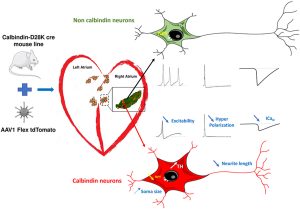Abstract
Background
The intrinsic cardiac nervous system is a complex system that plays a critical role in the regulation of cardiac physiologic parameters and has been shown to contribute to cardiac arrhythmias. To date, several types of neurons with distinct neurochemical and electrophysiologic phenotypes have been identified. However, no study has correlated the neurochemical phenotype to a specific electrophysiologic behavior. Calbindin-D28k, a calcium-binding protein, is expressed in numerous cardiac neurons.
Objective
Given that changes in neuronal excitability have been associated with arrhythmia susceptibility and that calbindin expression has been associated with modulations of neuronal excitability, our objective was to assess whether the cardiac calbindin neuronal population has specific properties that could be involved in cardiac regulation and arrhythmias.
Methods
By using a Cre-Lox mouse model to specifically target calbindin neurons with a fluorescent reporter, we characterized the neurochemical and electrophysiologic phenotype of this cardiac neuronal population.
Results
Calbindin neurons exhibit a specific neurochemical expression profile and a larger soma with shorter neurite length compared with other neurons. This was combined with a distinct electrophysiologic signature characterized by a lower excitability with a predominantly phasic profile associated to a lower N-type calcium current density.
Conclusion
Calbindin cardiac neurons display distinct neurochemical, morphologic, and electrophysiologic properties, resembling the cardiac neuronal remodeling observed in pathologic processes such as heart failure. Therefore, we believe that this specific neuronal population deserves investigation in the context of cardiac diseases.
Keywords:
Intrinsic cardiac neurons, Calcium current, Calbindin-D28k, N-type calcium channel, Autonomic nervous system
Cliquez sur le lien PubMed
Informations complémentaires


